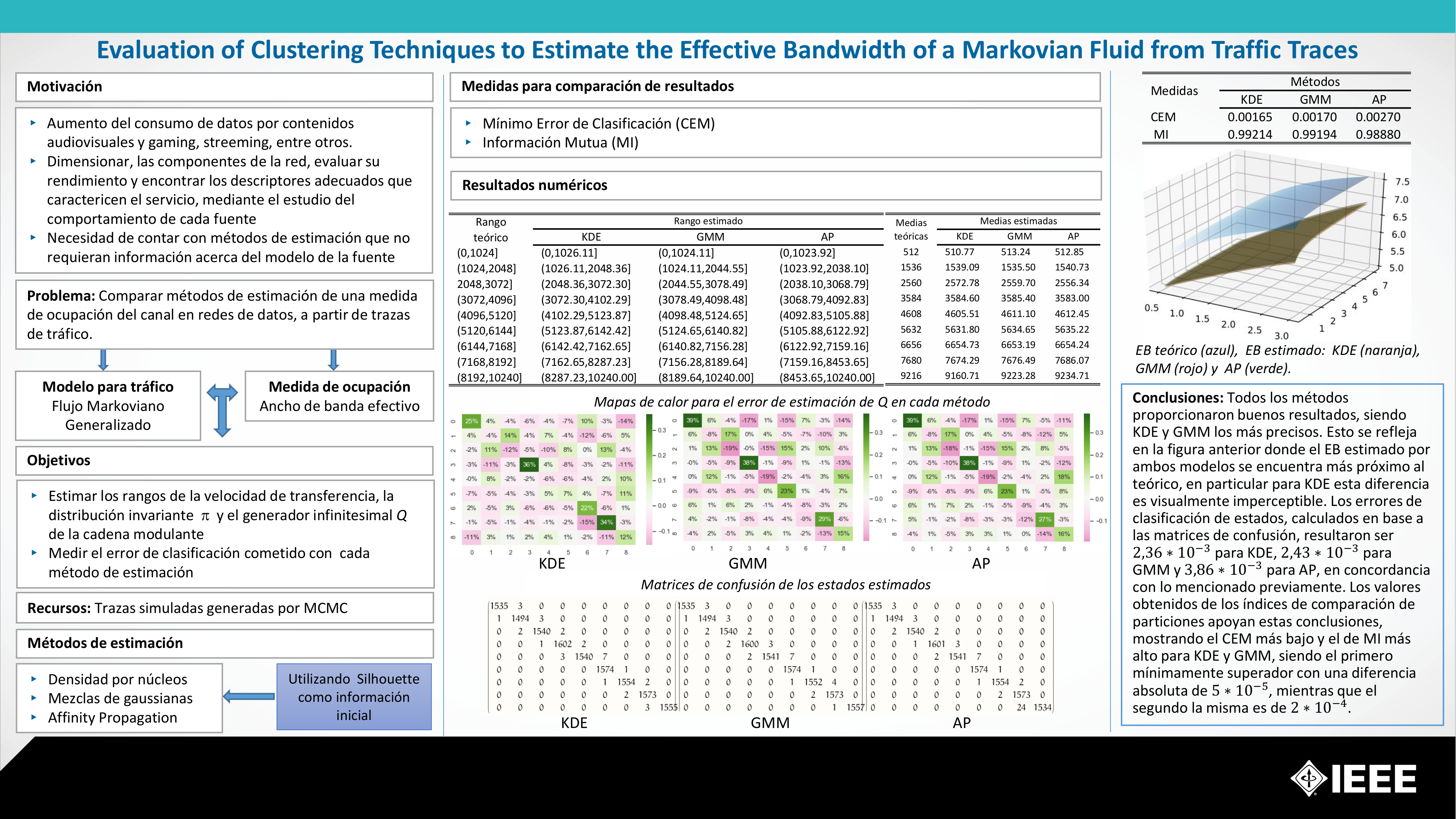Evaluation of Clustering Techniques to Estimate the Effective Bandwidth of a Markovian Fluid from Traffic Traces
Keywords:
Markovian fluid, Effective bandwidth, Supervised and unsupervised estimation methods, ClusteringAbstract
Integrated services digital networks, designed to transport data in real time, are modeled by a multiplexer system, where several data fluids share a single output. At the time of admission of a new connection, in order to maintain the quality of service (QoS), it is important to know the amount of available resources required by the connections sharing the channel. It is therefore important to have models for the sources and techniques that provide accurate estimates of the resources required for each of them. It is assumed that the network sources are modeled using the Generalized Markovian Fluid Model (GMFM) because of its versatility in describing traffic fluctuations. This is a Markovian fluid where the transfer rate is a random variable whose range and probability distribution are determined by the state of the modulating chain. To measure resource allocation, the concept of Effective Bandwidth (EB) is used, since it allows expressing this magnitude as a function of the model parameters, which will be estimated from traffic traces. As the size of the data to describe the behavior of a source is clearly enormous, they are studied using clustering techniques. In this work, different methods, supervised and unsupervised, are presented to estimate the parameters involved in the calculation of the EB. Finally, the performance of the estimators is analyzed by calculating partition comparison indices, corresponding to the dispatch intervals, which are based on the confusion matrix and the notion of mutual information entropy between partitions, on simulated data.
Downloads
References
F. P. Kelly, S. Zachary, and I. B. Ziedins, eds., Notes on Effective Bandwidth, pp. 141–168. Oxford University Press, 1996.
C. A. Courcoubetis and A. Dimakis, “The price of queueing,” ArXiv, vol. abs/2007.08318, 2020.
M. Zehri, A. Haastrup, D. Rincon, J. R. Piney, S. Sallent, and A. Bazzi, “A qos-aware dynamic bandwidth allocation algorithm for passive optical networks with non-zero laser tuning time,” Photonics, 03 2021.
J. Zhao, J. Du, Y. Yue, and J. Liu, “Special issue on advanced technique and future perspective for next generation optical fiber communications,” Photonics, vol. 9, p. 280, 04 2022.
A. Parra León, E. M. Piedrahita, and O. Salcedo, “Aplicaciones del modelo on/of al tráfico agregado en las redes de comunicaciones,” Tecnura, vol. 15, p. 129–147, jun. 2011.
A. Seal, A. Karlekar, O. Krejcar, and E. Herrera-Viedma, “Performance and convergence analysis of modified c-means using jeffreys-divergence for clustering,” International Journal of Interactive Multimedia and Artificial Intelligence, vol. In Press, p. 1, 12 2021.
J. Bavio, C. Fernández, and B. Marrón, “Comparison of effective bandwidth estimation methods for data networks,” Global Journal of Computer Science and Technology: ENetwork, Web & Security, vol. 22, no. 2, pp. 12–20, 2022.
M. Meila and D. Heckerman, “An experimental comparison of model-based clustering methods,” Machine Learning, vol. 42, pp. 9–29, 2001.
N. X. Vinh, J. Epps, and J. Bailey, “Information theoretic measures for clusterings comparison: Variants, properties, normalization and correction for chance,” J. Mach. Learn. Res., vol. 11, p. 2837–2854, dec 2010.
J. Bavio and B. Marrón, “Properties of the estimators for the effective bandwidth in a generalized markov fluid model,” Open Journal of Statistics, vol. 8, no. 1, pp. 69–84, 2018.
C. M. Bishop, Pattern Recognition and Machine Learning. Springer, 2006.
M. Rosenblatt, “Remarks on some nonparametric estimates of a density function,” The Annals of Mathematical Statistics, vol. 27, no. 3, pp. 832 – 837, 1956.
R. O. Duda and P. E. Hart, Pattern classification and scene analysis. Wiley, New York, 1973.
A. P. Dempster, N. M. Laird, and D. B. Rubin, “Maximum likelihood from incomplete data via the em algorithm,” Journal of the Royal Statistical Society: Series B (Methodological), vol. 39, no. 1, pp. 1—22, 1977.
E. H. Koroishi, F. A. L. Molina, A. W. Faria, and V. Steffen Junior, “Clustering by passing messages between data points,” Journal of Aerospace Technology and Management, vol. 315, pp. 972–6, 2007.
P. N. Tan, M. Steinbach, and V. Kumar, Introduction to Data Mining. Pearson Addison Wesley, 2005.
L. Kaufman and P. Rousseeuw, Finding Groups in Data: An Introduction To Cluster Analysis. Wiley, New York, 1990.
F. Pedregosa, G. Varoquaux, A. Gramfort, V. Michel, B. Thirion, O. Grisel, M. Blondel, P. Prettenhofer, R. Weiss, V. Dubourg, J. Vanderplas, A. Passos, D. Cournapeau, M. Brucher, M. Perrot, and E. Duchesnay, “Scikit-learn: Machine learning in Python,” Journal of Machine Learning Research, vol. 12, pp. 2825–2830, 2011.
C. E. Shannon, “A mathematical theory of communication,” The Bell System Technical Journal, vol. 27, no. 3, pp. 379–423, 1948.


